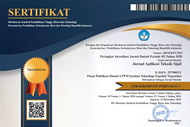Microwave Incinerated Rice Husk Ash Influence on Foamed Concrete Workability
Abstract
This paper presents the study of Microwave Incinerated Rice Husk Ash (MIRHA) Influence on Foamed Concrete (FC) Workability. The mix proportion of the MIRHA FC was designed using the Taguchi method with L16 orthogonal array with five parameters, namely, MIRHA contents, water cementitious ratio (w/c), sand cement ratio (s/c), superplasticizer (SP) content, and foam content. The workability of the foamed concrete was evaluated through spread measurement in accordance with ASTM-230. The results showed that FC incorporating MIRHA shows lower spread result than normal FC. MIRHA content has contribution 5-15% for workability which a stabled and consistent FC could be achieved. The contribution of MIRHA parameter to achieve the required workability of FC was 12.06%.
Keywords
Full Text:
PDFReferences
ASTM-C33 (2003). Standard Specifica-tion for Concrete Aggregates. In "Annual Book ofASTM Stan-dards, Vol.04.02," (A. S. f. T. a. Materials, ed.), Philadelphia, USA.
ASTM-C230 (2003). "Standard Specifi-ca¬¬tion for Flow Table for Use in Tests of Hydraulic Cement.
ASTM-C796-97 (1997). Standard Test Method for Foaming Agents for use in producing cellular con-crete using Preformed Foam.
ASTM-C869-2006 (2006). Standard Test Method for Foaming Agents for used in Making Preformed Foam for cellular concrete.
Jones, M. R., and McCarthy, A. (2005). Behaviour and assessment of foamed concrete for construc-tion applications. In "Procee-dings of the International Con-ference on the Use of Foa¬med Concrete in Construction", pp. 61-88.
Kearsley, E. P., and Wainwright, P. J. (2001). The effect of high fly ash content on the compressive strength of foamed concrete. Cement and Concrete Research 31, 105-112.
Kearsley, E. P., and Wainwright, P. J. (2002). Ash content for opti-mum strength of foamed concrete. Cement and Concrete Research 32, 241-246.
L. D’Aloia Schwartzentruber, R. Le Roy, and Cordin, J. (2006). Rheological behaviour of fresh cement pastes formulated from a Self Compacting Concrete (SCC). Cement and Concrete Research 36, 1203–1213.
Lee, H. K., Kim, H. K., and Hwang, E. A. (2010). Utilization of power plant bottom ash as aggregates in fiber-reinforced cellular concrete. Waste Management 30, 274-284.
Nehdi M., Duquette, J., and El-Damatty, A. (2003). Perfor-mance of rice husk ash produced using a new technology as a mineral admixture in concrete. Cement and Concrete Research Vol.33, No.8, 1203-1210.
Neville, A. M. (2006). " Properties of Concrete (4th edn). Longman, London."
Pan, Z., Hiromi, F., and Wee, T. (2007). Preparation of high performance foamed concrete from cement, sand and mineral admixtures. Journal Wuhan University of Technology, Materials Science Edition 22, 295-298.
Roy, R. (1990.). A primer on the Taguchi method.
Tiong-Huan Wee, D. S. B., T. Tamilselvan, and Hwee-Sin Lim (2006). Air-Void System of Foamed Concrete and its Effect on Mechanical Properties. Materials Journal.
Wang, K. S., Chiou, I. J., Chen, C. H., and Wang, D. (2005). Light-weight properties and pore structure of foamed material made from sewage sludge ash. Construction and Building Materials 19, 627-633.
DOI: http://dx.doi.org/10.12962/j12345678.v12i2.2580
Refbacks
- There are currently no refbacks.

Jurnal Aplikasi Teknik Sipil by Pusat Publikasi Ilmiah LPPM Institut Teknologi Sepuluh Nopember is licensed under a Creative Commons Attribution-ShareAlike 4.0 International License
Based on work at https://iptek.its.ac.id/index.php/jats




